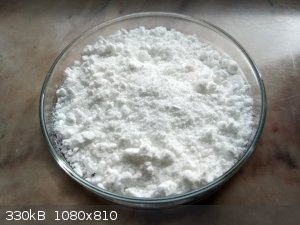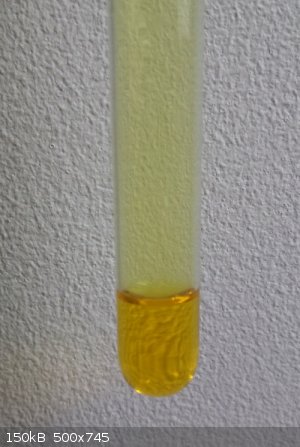EthidiumBromide
Harmless

Posts: 42
Registered: 27-9-2020
Member Is Offline
Mood: Effervescent
|
|
Crystallization of NaClO2 from solution?
I have a 25% solution of sodium chlorite (NaClO2). I would like to crystallize the chlorite to get a solid sample, given that the chem suppliers here
only have solutions of it and never the solid compound. But I'm not sure how to go about it. Is NaClO2 stable enough to just boil off the water or
will it decompose upon heating (as sodium hypochlorite does)?
I've checked out two research papers and it appears that the addition of some NaOH stabilizes the chlorite and prevents decomposition. It also seems
that the trihydrate forms below 38°C, above that transition temp, saturated solutions will crystallize the anhydrous form.
http://scripts.iucr.org/cgi-bin/paper?a12346
https://pubs.acs.org/doi/pdf/10.1021/ja01608a087
The existence of the hydrated form brings me to my next question - what about KClO2? There's noticeably very little information to go off of for the
potassium salt. Is that because it's less stable than NaClO2 or is it just because it's much less common? Is there a significant difference in
solubility that would allow me to recover the potassium salt more easily? (in the way it's easier to isolate KClO3 by first thermally
disproportionating NaClO into NaCl and NaClO3 and then adding a KCl solution to precipitate KClO3, rather than trying to isolate NaClO3). I just want
the best yield of recovery I can get from my 25% solution, it doesn't matter if it's the sodium or potassium salt.
Alternatively, is there any water-miscible solvent I could add to precipitate the NaClO2?
I also recall that solid chlorites are not particularly stable, unless it's a mixture of chlorite and chloride in equilibrium. That's not a problem, I
would just like to prepare a solid sample in a small quantity to do a few experiments and do not intend to store it for prolonged time.
[Edited on 13-10-2020 by EthidiumBromide]
|
|
|
B(a)P
International Hazard
    
Posts: 1114
Registered: 29-9-2019
Member Is Offline
Mood: Festive
|
|
Did you see this one?
https://pubs.acs.org/doi/pdf/10.1021/ie50367a007#
|
|
|
symboom
International Hazard
    
Posts: 1143
Registered: 11-11-2010
Location: Wrongplanet
Member Is Offline
Mood: Doing science while it is still legal since 2010
|
|
I wonder if they is other thing that can stabilize sodium chloride within a double salt.
|
|
|
EthidiumBromide
Harmless

Posts: 42
Registered: 27-9-2020
Member Is Offline
Mood: Effervescent
|
|
Thanks, it seems in my googling efforts I didn't type the the most simple phrase - sodium chlorite properties.
Apparently NaClO2 solutions are stable enough to withstand 2 hours of boiling without significant decomposition and as the anhydrous solid survives
temperatures up to 150°C with no signs of decomposition. Explosive decomposition is only a risk in case of organic contamination, which with very
clean glassware shouldn't be an issue. So with careful temperature management it should be possible to even obtain the anhydrous form. Either way,
this is a small scale experiment to try, in the off chance it decides to somehow throw a fit and do something nasty. I probably won't dehydrate it all
the way either, instead I'll leave some residual water and collect the NaClO2 through filtering, being still hot it should be mostly the anhydrous
form.
|
|
|
EthidiumBromide
Harmless

Posts: 42
Registered: 27-9-2020
Member Is Offline
Mood: Effervescent
|
|
So I gave the evaporation of chlorite solution a go. I measured 100 ml of the 25% NaClO2 solution and started to boil it down. At approximately 1/3
the original volume, the NaClO2 started precipitating from solution. The solution was boiled down until it reached 1/4 of the original volume (it was
roughly 25 ml), with some residual water still left. I let it cool down to about 60°C. Now, in light of organics making chlorites potentially
shock-sensitive, I took the rather risky move of adding ethanol to the still warm liquor, hoping that it would make drying the product easier by
removing some of the water and potentially even precipitate more of the NaClO2 from the liquor (first trying it on a 1 ml sample to see if anything
bad happens). Nothing bad happened in the 1 ml sample nor the whole batch, so I continued by collecting the solid NaClO2 through filtration. The
ethanol definitely helped somewhat, prior to addition the precipitate was a mushy, unattractive mass, but the ethanol made it a nice, loose and
powdery precipitate. After transferring the product to the filtration setup, I washed it a bit more with some cold 96% ethanol. At this stage I
decided to test if the powder moistened with ethanol was shock sensitive, just in case. I took roughly 0.25 g and hit it with a hammer on a hard metal
surface, nothing happened (but this is no guarantee that nothing bad can happen between dry NaClO2 and anhydrous ethanol, proceed with caution if you
decide to add ethanol).
After that I left the product to air dry, stiring the powder occasionally to speed it up. The mass hardened as it dried out, so I broke it up and
grinded it with a mortar and pestle (the ethanol had dried out as no scent could be picked up, but I could tell the product didn't completely dry off
from the water). The crushed powder was then transfered and weighed. I got 20.31 g, but since I dont think the NaClO2 has fully dried out yet (I might
put it in a dessicator bag) this shouldn't be taken as the final yield.
I didn't bother with taking pictures of the setup or the procedure, as it was pretty basic. The solution was evaporated in a 250 ml beaker on a
"kitchen" hotplate (yes, I'll upgrade to a proper hotplate with magnetic stirring soon), the product was filtered on a glass funnel with filter paper
and a simple water aspirator providing the vacuum. Below is a photo of the crushed up, partially dried product. Looks perfectly white on the photo,
but in person there is a very subtle yellowish tint.

I decided run a few tests to confirm that it is indeed chlorite and not chlorate, for instance. I added the powder to some dilute H2SO4 in a test
tube. It made a few popping noises, as the solution turned yellow and some vivid greenish-yellow ClO2 gas collected above the liquid.

The final expermiment was checking the reactivity with ascorbic acid. 1 g of the obtained NaClO2 and 1 g of ascorbic acid was transferred into a
crucible. The two powders were very gently mixed (avoiding friction) and left alone. After approx. 30 seconds the mixture spontaneously deflagrated on
its own. A similar test was conducted with KClO3 (the only chorate I had on hand, otherwise I would have tested it with NaClO3). After 20 minutes of
sitting at ambient temperature, nothing happened and the mixture was heated manually to ignite.
That pretty much confirms that the powder is mostly NaClO2. I suppose I have no real way of assesing the purity of the product (maybe some titration
of sorts?). Anyway, that would be about it.
|
|
|
woelen
Super Administrator
        
Posts: 7976
Registered: 20-8-2005
Location: Netherlands
Member Is Offline
Mood: interested
|
|
I know from experience that NaClO2 is quite stable. I have a 28% solutoin and I left some of this in a petri dish on a warm radiator (50 C or so).
After one day I had a white dry crust, which could be scraped off and ground to an irregular powder (some pieces are larger than 1 mm, while there
also is very fine powder).
The material definitely is NaClO2 and not NaClO3. On addition to conc. HCl a lot of ClO2 is formed, but there is no smell of Cl2. ClO2 has quite a
different smell. With NaClO3 the smell of Cl2 overpowers the smell of ClO2, when it is added to conc. HCl (with NaClO3 you get an appr. 1 : 2 mixture
of Cl2 and ClO2).
|
|
|
Bedlasky
International Hazard
    
Posts: 1219
Registered: 15-4-2019
Location: Period 5, group 6
Member Is Offline
Mood: Volatile
|
|
Quote: Originally posted by EthidiumBromide  |
That pretty much confirms that the powder is mostly NaClO2. I suppose I have no real way of assesing the purity of the product (maybe some titration
of sorts?). Anyway, that would be about it. |
Chlorites can be determine by iodometry.
|
|
|
EthidiumBromide
Harmless

Posts: 42
Registered: 27-9-2020
Member Is Offline
Mood: Effervescent
|
|
Thank you for your inputs, Woelen and Bedlasky.
Indeed the solid chlorite generates ClO2 exclusively. I am familiar with the smell. It's the odor of dichloroisocyanurate based disinfectants so I
recognized it immediately. Very smelly, and I'd say even less bearable than chlorine.
I'll probably use up the solid NaClO2 quickly so I won't perform any titrations, but it's good to know that it can be done iodometrically.
|
|
|